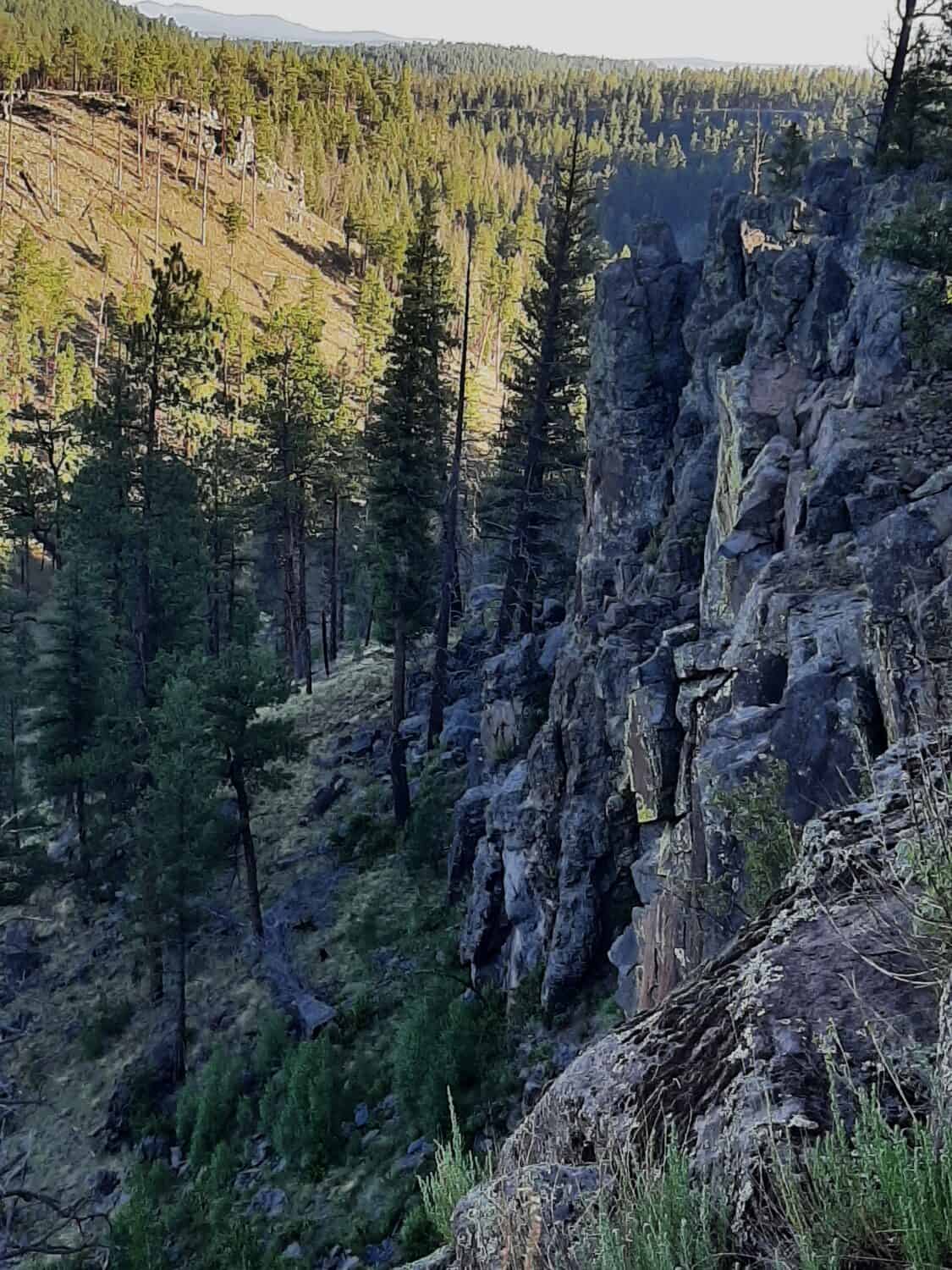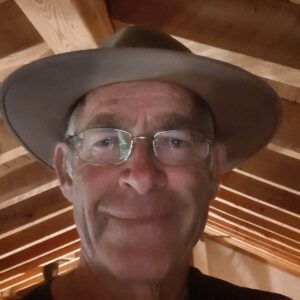First night of the trip and I am camping near the edge of an eighty-foot-high basalt, rimrock cliff with the pulsing roar of the running river coming up the walls from far below in the dark. An owl, I think a Spotted, is hooting far below as well. In the morning I know I’ll be sipping my coffee and gazing across the canyon at the most likely site for the incident that led Leopold to write Thinking Like a Mountain. I had intended to camp there across the river, but a slow-moving grass fire has been sweeping underneath around 1000 acres of pine forest and so the road on the west side is closed. The thin smoky tendrils were still rising through the pine foliage, the charred scent of a recent burn hanging lightly in the air.
Even when one has driven ten miles or more off a lightly used highway, the sounds of human actions are ever present, being harsh in competition with the soothing sounds of nature. The melody of rippling waters goes well with crickets and owls. Cow bellows, rumbling trucks and jets overhead are intrusive when one is sitting wrapped in nature.
Before supper tonight, my dear friend Don Hoffman, who knows this land far better than most, led me down a side canyon to the river below. We walked along the river’s edge while a faint pallor of smoke hung in the air. The fire had burned the grasses cladding the rock talus slope down to the river for quite a distance. As we approached a high rocky knob across the river, Don mentioned that he had seen Bighorn Sheep up on that stony crag before. Suddenly, as if on cue, a Big Horn Sheep ram stood silhouetted high against the sky, his curled horns dark against the vivid blue. Then more graceful shapes began appearing and coming down the slope, heading for water and the lush green grass thriving in the canyon bottom. The ram bounded down the rocky face and took a position between us and his herd. I cautiously approached and eventually was standing maybe fifty feet from the ram herd with the river waters between us. They were not afraid, nonchalantly munching as they watched me watching them. I am sure the awe was much more from my side of the viewing.
It is hard to pull away from the ultimate. Most likely I will never have the chance to stand so close to such beauty again. We absorbed the experience and then reluctantly said goodbye and continued on our way up canyon. The signs of the 500,000 acre Wallow Fire are still there reminding one with burnt snags candling the mountainsides and charred debris piles from heavy flooding littering the canyon floor.
I am always amazed at how good even soggy fried chicken can taste after a challenging hike and then relaxing afterwards at the edge of a mighty canyon. We spoke of many things I’m sure Aldo would have had thoughts on as well before Don headed back to his home on the Campbell Blue and left me the in blessed solitude.
I woke twice in the night to a soft rain which teased me into guessing if it was of short duration or going to settle in and soak me. The front seat of the car was not as comfortable a resting place but did provide welcome dry shelter. I did venture out to sleep once more under the stars and a brilliant moon just a day past full. Lulling me back to sleep was a nearby owl hooting and a far-off coyote yipping in the moonlight.
I find myself now sipping coffee at the tumbled edge of the lichen encrusted rimrock cliff, in the moon bathed dark as dawn begins its easing into day. I reread Aldo’s essay Thinking Like a Mountain as I peer into the dark canyon, the roaring of the Black River filling the void below.
I wasn’t fortunate enough to hear what Leopold describes as a “deep chesty brawl echoing from rimrock to rimrock, rolling down the mountain and fading into the far blackness of the night” He said, “It was an outburst of wild defiant sorrow and contempt for all the adversities of the world.” It was a lone coyote who provided the night music for my yearning ears.
The morning light slowly kisses the tops of the pine capped rimrock across the canyon. I watch and sip as the light dance of the day marches down the conifer trunks and onto the rimrock cliffs and eventually greets the talus slopes above the rivers edge. It is a wonderful symphony of early light and river sound. Just below me, a movement catches my eye. I realize I am looking down on a four foot wide nest of sticks draped with lichens built on the snapped off top of a fifty-foot snag. The flash of white is what caught my eye as the owner landed. I saw long dark wings with big patches of white on the head and chest. I rushed back to the car for my binoculars and as is often true with observing nature, the moment had passed by the time I was back at rimrock edge. I wait and sip, wait and sip but his majesty does not grace my view again. The lichens on the rimrock edge by my feet are glowing after the light rains and in the early sunlight. A freshly leafed out Canyon Grape, aptly named, gives a vibrant touch to the basalt edge, morning has broken.
Patience is a virtue and a luxury at times. The trail down the rimrock to the roaring river below beckons. I heed its call and forgo the opportunity to see who the nest builder was. With all of the white I saw I wonder if it was an Osprey. The river with its trout lies just below the snag and seems a likely place for the mighty bird. But now the canyon calls me, and I am off to plunge down through the rimrock breaks to the alluring deep pools below,
The trail is steep and rocky but after thirty minutes of walking past lichen draped rocky snags and wildflower splendor, a few oohs and ahhs cast in, I arrive down at the rivers edge. The big pool lying up against the cliff wall must be two hundred feet long, twenty feet wide and deep. The perfect summer swimming hole indeed. I turn and gaze back up at the rimrock wall below my campsite. It does not seem as daunting a height from here as it did while standing on the edge above. There are thick stands of willows, conifer snags and house size boulders scattered below the rocky wall on the steep talus slope. I found myself wondering how Leopold and his crew made their way down that face to witness the fierce green fire in that dying wolfs eyes. I wonder which pile of broken slabs the injured pup crawled into for shelter and safety. Aldo was here in 1909, 114 years have passed and yet the scene I imagine is very much the same as it was back then.
It is reassuring to know that even with our ever-expanding population, there are still areas of our country that retain wild lands. They are not the endless sweeps of wilderness that the early settlers experienced but pockets of wild. As I drove the forest road, I had a flash of “big animal” bound across the road on a curve. I stopped and looked and there, framed by an opening in the pines, was an Elk bull with at least a seven-foot-wide rack. He reminded me of the Hartford Insurance buck. He had wheeled around and was majestically facing me with at least 20 elk cows behind him. A nature wow indeed. How anyone could bring themselves to shoot and kill such an amazing creature, I’ll never know. I am part of his community, not his deity to decide life or death at a whim. The three wild turkey hens standing in the road had a rather nonchalant attitude towards survival. Maybe it was just a trusting natural curiosity that kept them close to gaze at me as I was gazing at them. I’m always amazed at how well they fly for such a bird of fine stature; they are big. It is a special sight to find a rafter or flock of them nested for the night high up in a Ponderosa Pine. They were almost hunted to extinction in the 1930’s and now their population is thought to be more seven million and growing.
A story of another amazing animal but with extincting results, is that of the Passenger Pigeon. In the 1850’s, they were thought to have had a population of over 3 billion. Sixty years later, a mere sixty years later, the last Passenger Pigeon passed away in captivity. On September 1, 1914, Martha the last survivor of her entire species, died at the Cincinnati Zoo. 3 billion birds gone from existence in only 60 years. That was an atrocity equal to the Nazi extermination of Jews in World War II. Leopold said, “We abuse land because we regard it as a commodity belonging to us. When we see land as a community to which we belong, we may then begin to use it with love and respect.” Although it sometimes seems that we are not capable of love and respect of anything but ourselves, I know that is not the truth. Most people carry love and respect for life most of the time. There are the few evil beings who color perception with their news catching atrocities. We need to remind ourselves of that and reach out with intentional compassion to ensure the well being of others, whether they walk, fly, or crawl or stay stationery and sway in the winds of change. Staying aware of what is actually happening around us and engaging in its responsibility is crucial for our community’s health. Enjoy.

